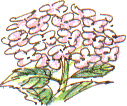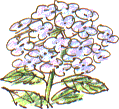 |
Litmus TestWednesday 25th July 2001, West Yorkshire |
![]()
![]()
![]()
![]()
![]()
![]() This Month
Rocks
History
Workshop
Links
Home Page
This Month
Rocks
History
Workshop
Links
Home Page
![]()

 MOST HYDRANGEAS in local gardens are pink, but at the weekend, when we were in Cumbria, I was struck by how different they looked with blue flowers. With garden varieties, it's usually the acidity of the soil that dictates the colour. In acid soils, with a pH below 5.5, hydrangeas produce blue flowers, in alkaline soils, above pH7 they will be pink.
MOST HYDRANGEAS in local gardens are pink, but at the weekend, when we were in Cumbria, I was struck by how different they looked with blue flowers. With garden varieties, it's usually the acidity of the soil that dictates the colour. In acid soils, with a pH below 5.5, hydrangeas produce blue flowers, in alkaline soils, above pH7 they will be pink.Curiously this is the opposite to the litmus test in chemistry. Litmus paper is reddened by an acid. Litmus is a soluble blue powder obtained from various lichens.
No doubt, the acidity of the soil varies greatly between West Yorkshire and Cumbria, but I've noticed that even locally, there is a range of colours. Keen gardners, who feel they really must get a particular colour have the option of adding an hydrangea colourant to the soil, which changes the acidity.
Garden varieties of hydrangea, which are classed either as 'Hortensias' or 'Lacecaps' are descended from two wild Japanese species;
- Hydrangea marcophylla grows in the wild in Honshu, Izui and the Chiba peninsula near Tokyo in sunny places on shores. It forms thickets up to 3 metres in height.
- Hydrangea serrata grows in woods in mountains up to 1500 metres in Honshu, Shikoku and Kyushu.
Another garden shrub, the 'mock orange', Philadelphus coronarius, is a relative of the hydrangeas.
![]()
Richard Bell,
wildlife illustrator
E-mail; 'richard@willowisland.co.uk'
![]() Next page
Previous page
This day last year
This month
Nature Diary
Home Page
Next page
Previous page
This day last year
This month
Nature Diary
Home Page
![]()